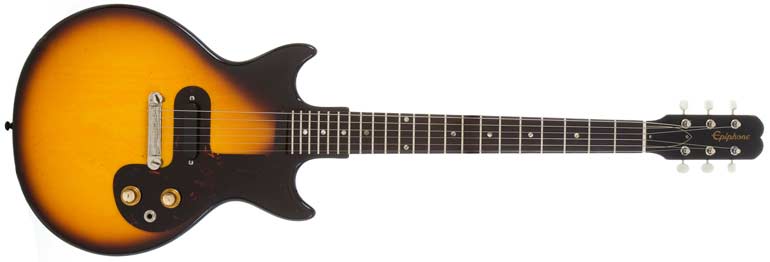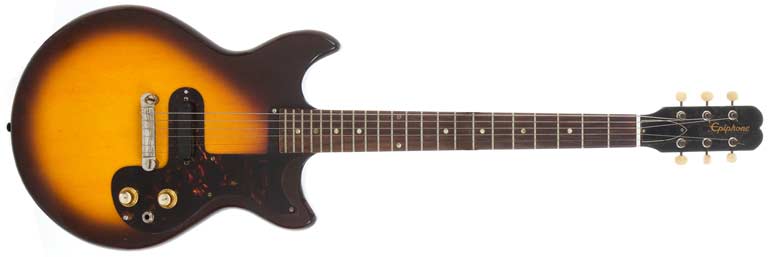
The Epiphone Olympic Special is not that well known an instrument - often being confused with the Epiphone Olympic, but with very good reason; the Special actually evolved from the Olympic in 1963. A 1961-63 Olympic basically is a 1963-64 Olympic Special, though outside those time periods there are distinct differences. Just under 3000 Epiphone Olympic Specials were shipped between 1963 and 1969. For a break-down of the production stats, see the Epiphone Olympic Special shipping totals.
The solid body Epiphone Olympic (not the Olympic Special) first appeared on the market in 1960. Like so many Epiphone guitars of the time, it was closely related to an equivalent guitar model, in this case the Gibson Melody Maker. Gibson parent company CMI, had just purchased Epiphone, and had moved production from the Epiphone plant in Philadelphia, to Gibson's facility in Kalamazoo, Michigan. Epiphone had never built solid body guitars, and a new range of guitars was introduced. The same business model was used as Gibson's other lines: have one basic guitar model, and offer several incarnations, with increasingly better hardware and appointments at a range of different prices. The first models were the Coronet and Crestwood Custom, followed by the Wilshire and Olympic in 1960. Having being based on the Melody Maker, the Olympic was different to all the other Epiphone solid bodies. In 1960 this was a single cutaway Les Paul style guitar. Both these models were updated to the double cutaway style in 1962.
Then in 1963 the rest of the Epiphone solid body range got a makeover: less 'round' with an extended top horn and wonderful batwing headstock. This is the classic style most-associated with Epiphone solid bodies. But the Olympic was also given this new body style. The old Melody Maker-style Olympic was not deleted however, instead was renamed the Olympic Special. Only the single pickup version was available, but with an optional Maestro Vibrola.
 Image Heritage auctions
Image Heritage auctions
All other Epiphone models remained unchanged until production moved to Japan in 1970, but the Olympic Special was the one exception. In 1964 the cutaways were re-shaped somewhat; less symmetrical, with a slightly longer top horn, and with better upper fretboard access. The neck joined the body at the 18th fret, rather than the 16th fret of the previous style.
 Image Heritage auctions
Image Heritage auctions
$999
$2500
$2695
$1600
$1450
$1500
$2795
$1499
$3300
€1745
€1295
€1350
£1698
£1179
€1333
€1350